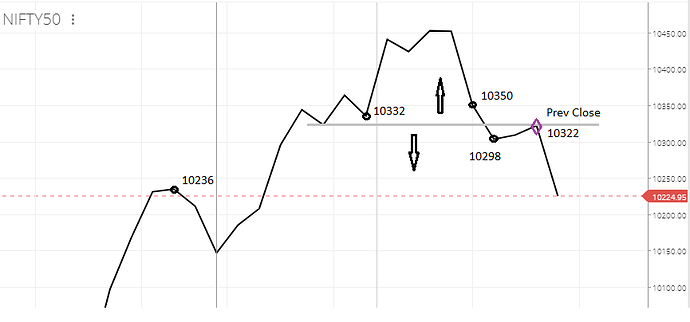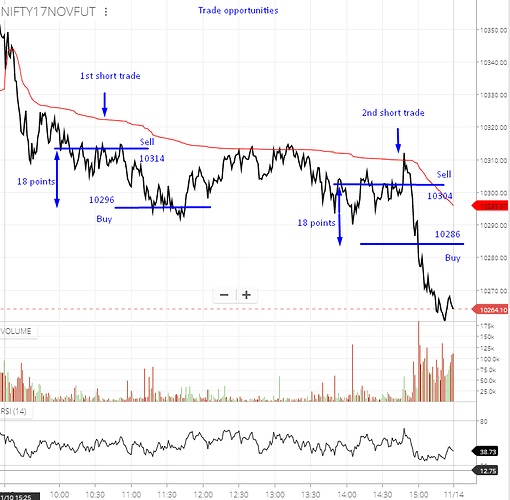I am going to break down today’s trades for you in the same manner in which it was written above.
- Nifty close to previous close
Close(12 Nov) : 10322
Prev Close : 10309
Although the close was higher than the prev close, it was still lower than the closing prices of 9 trading sessions before 11 Nov.
- Immediate Nifty testing levels : From previous close.
Pick the closest 2 closing price levels above previous close and the closest 2 closing price levels below.
Closest/immediate 2 upward testing levels: 10332, 10350
Closest/immediate 2 downward testing levels : 10298, 10236
- Nifty trend over different timeframes
NIfty 3-day trend:  Flat
Flat
Nifty 5-day trend: 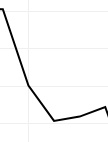 Down
Down
Nifty 14-day trend: 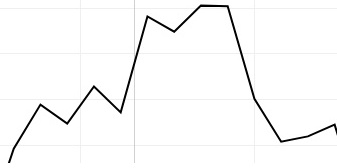 Range-bound
Range-bound
- Trend crucial levels
Upward resistance: 10352
Downward support: 10292
- Support/Resistance levels formed in the first 1 hour of market:
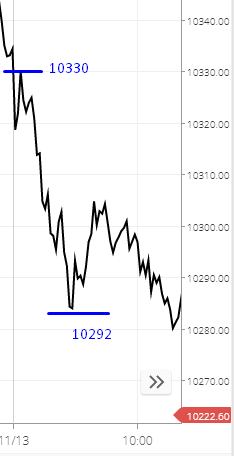 Although Nifty tested the first immediate upward level, it very soon tested the first immediate lower level as well.
Although Nifty tested the first immediate upward level, it very soon tested the first immediate lower level as well.
- Weight of the index(buyers v sellers) : Weighing down, sellers were in control
After testing 10292, Nifty was unable to cross 10308 and only came down to break 10292 again within the first 1 hour of market itself.
Note: The study of levels is performed on Nifty charts and the trades are executed in Nifty Futures. The index charts are slightly more well behaved and less volatile compared to the future charts.
Also, ideally one must enter into a trade only after the market pans out for an hour in order to get all the above information.
- VWAP For intraday trend analysis: Trend was down through the day
Added RSI for reference of overbought/oversold regions. You could use this in conjunction with Stochastics. You could use another layer of candlestick patterns to double okay your trade entry and exit if it’s not too much to do at once.
Basic price action: Price movement+chart pattern+volume.
When it comes to price movement, selling occurs from the highest price points for the region of consideration, buying occurs from the lowest price points, markets are usually overbought/oversold, a scrip will always test a given level before making the next move. General guidelines like that.
- Proper risk management(position sizing, trailing stoploss, definitive target).
Position sizing: this depends on your capital. If the rule of thumb is that you shouldn’t lose more than 5% of your trading capital and assume you have 2 lacs of trading capital, then you can’t lose more than 10k on any trade. If you are trading 4 lots of Nifty Fut(300 qty), then you cannot lose more than a 30 point movement on the opposite side of your trade. This would permit of stoploss of anywhere between 0.2%-0.3%. Alternatively, 0.1%-0.3% is a great definitive target point depending on the trade setup, so,
Position size: 4 lots of Nifty Futures(300 qty)
Definitive target(in this case): 0.18% = 18 points
Stoploss: 0.025% = 25 points
Profit:
1st trade: 300 qty * 18 points = Rs. 5400
2nd trade: 300 qty * 18 points = Rs. 5400
Alternate second trade qty(half the quantity of the first trade)
Alternate second trade: 150 * 18 = Rs.2700.
Trailing the stoploss : It a natural progression of the trade setup. Once the trade setup is in your favour, you can trail. If your target is definitive no matter what, then a trailing stop loss can also be avoided. If the trade day is of one-sided movement only, upward trend or downward trend, then that’s an ideal setup for a trailing stoploss.
If the trade does not go in your favour, cut your position. Do not overtrade/increase stoploss/increase quantity. If you are indecisive after entering a trade, cut your position, take a small walk and come back to reanalyze.
